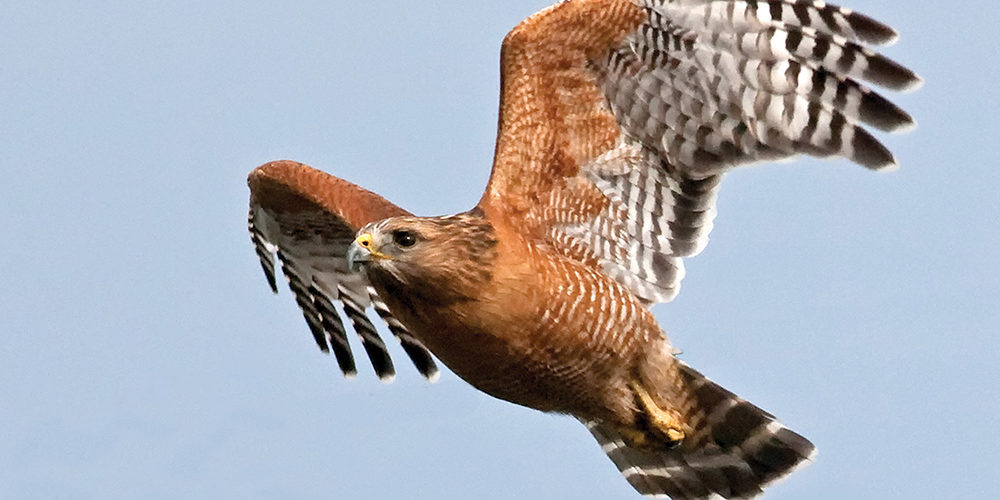Bird of The Week: Red-shouldered Hawk
SCIENTIFIC NAME: Buteo lineatus
POPULATION: 1.6 million
TREND: Stable
HABITAT: Deciduous or mixed forests, often near clearings and water; swamps
The Red-shouldered Hawk is named for its reddish upper wing coverts, or shoulders. The lineatus in its name means “striped” in Latin, referring to its black-and-white-banded tail and finely barred reddish breast. Another distinctive field mark: translucent wing crescents, or “windows,” near the base of the wingtips, visible when the bird soars or glides overhead.
This attractive raptor is smaller and slimmer than the more widespread Red-tailed Hawk, almost resembling an accipiter such as the Cooper’s Hawk.
Sharing the Swamp
In the eastern United States, the Red-shouldered Hawk and the Barred Owl often share the same swampy woodlands and riparian areas, where they prey on similar animals. However, the hawk is active during the day and the owl at night, so conflict between the two species is kept to a minimum.
This habitat-sharing can be observed in other raptor species, such as the Northern Harrier and the Short-eared Owl, which take the day and night shifts, respectively, in the open pastures and marshy fields they favor.
Red-shoulders, East and Pacific
Red-shouldered Hawks breed throughout the eastern and northeastern United States, into southern Canada. A separate population breeds west of the Sierra Nevada mountains along the Pacific Coast. Populations in much of the eastern U.S. and in the West are resident, but populations that nest in the northeastern U.S. and southern Canada migrate as far south as Mexico for the winter.
Five Red-shouldered Hawk subspecies are recognized, based on geographic distribution and physical characteristics. The South Florida subspecies has paler markings and a lighter overall appearance than other Red-shouldered Hawks, while the West Coast subspecies has an especially striking black-and-white checkerboard pattern on the back.
Noisy Courtship
Red-shouldered Hawks are among the noisiest of North American raptors, with a repertoire of at least seven different calls. Their distinctive calls are often mimicked by Blue Jays.
Red-shouldered Hawks are very vocal when disturbed at their nests, particularly if a potential predator such as a Great Horned Owl is seen nearby. They are also noisy while courting. During one courtship display, a pair soars in broad circles while giving a series of three to four screaming kee-aah calls. Males also vocalize during a solo display, circling high into the air, then descending in a steep dive, followed by a rapid, spiraling ascent.
After mating, both birds of a pair build a large stick nest, which they often reuse from year to year. Both parents aggressively defend the nest and incubate the eggs. The female broods the chicks during their nestling stage, while the male brings food to the nest. Both parents feed the young after they fledge.
Frog Feeder
Red-shouldered Hawks prefer to hunt from a perch in the forest understory; they also fly low through the forest, pouncing on prey in a stealthy surprise attack. Aquatic and semi-aquatic animals, particularly frogs, small fish, snakes, and crayfish, are mainstays of the Red-shouldered diet, but the birds will also catch lizards, rodents, smaller birds, and large insects.
Like many birds of prey, Red-shouldered Hawks are opportunistic and will take advantage of almost any potential source of meat, including carrion.
Addressing a Wide Range of Threats
The Red-shouldered Hawk population declined steeply early in the 20th century due to hunting and habitat loss. After the Migratory Bird Treaty Act banned hunting of many wild birds, this hawk’s numbers began to recover, and reversion of farmlands to forest in the northeastern U.S. has also begun to restore large swaths of forest habitat that this species requires.
Red-shouldered Hawks remain vulnerable to collisions with cars, powerlines, and wind turbines, which threaten many other raptor species, including Swainson’s Hawks and Golden Eagles. Red-shoulders are still accidentally poisoned by pesticides and industrial pollutants, and breeding pairs may abandon their nests due to disturbance from logging and recreational activities such as hunting, hiking, and use of off-road vehicles.
Source: American Bird Conservancy (abcbirds.org)


